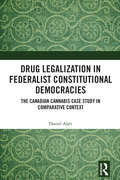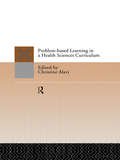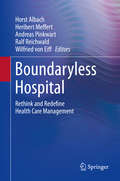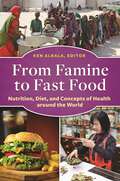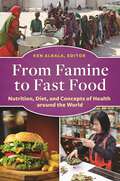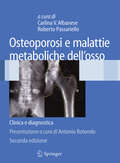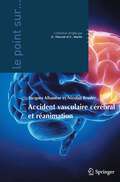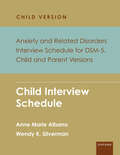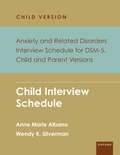- Table View
- List View
Managing Risk during the COVID-19 Pandemic: Global Policies, Narratives and Practices
by Andy AlaszewskiThe past 30 years have seen risk become a major field of study, most recently with the COVID-19 pandemic positioning it at the centre of public awareness, yet there is limited understanding of how risk can and should be used in policy making. This book provides an accessible guide to the key elements of risk in policy making, including its role in rhetoric to legitimise decisions and choices. Using risk as a framework, it examines how policy makers in a range of countries responded to the COVID-19 pandemic and explains why some were more successful than others.
Making Health Policy: A Critical Introduction
by Andy Alaszewski Patrick BrownThis new textbook opens up the policy-making process for students, uncovering how government decisions around health are really made. Starting from more traditional insights into how ministers and civil servants develop policy with limited knowledge and money, the book goes on to challenge the conception of policy as a rational process, revealing it to be something quite different. Knee-jerk reactions to disasters, keeping voters satisfied, the powerful leverage of interest groups, and the skewing of debate through ideology and the media are each considered in turn. These processes render policy far from rational or at least require a much broader approach for considering policy ‘logic’, one that is open to different rationalities of values, norms and pragmatism. The book draws on historical and contemporary examples to highlight that though challenges to policy-makers may seem in some ways novel, in many senses key processes endure and indeed are rooted in historical contexts. Although the examples are drawn from UK health and social care, the book’s theory-driven approach is applicable across national contexts Ð especially for countries where uncertainty, risk and resource pressures create significant dilemmas for policy-makers. The book’s multi-perspective, thematic approach will be especially relevant to students, as will the broad range of case study examples used. Making Health Policy will be essential reading for students of health policy, social policy, social work, and the sociology of medicine, health and illness.
Drug Legalization in Federalist Constitutional Democracies: The Canadian Cannabis Case Study in Comparative Context
by Daniel AlatiThis book uses the Canadian Cannabis legalization experiment, analyzed in the historical context of wider drug criminalization in Canada, and placed in international perspective, to examine important lessons about the differential implementation of federal law in jurisdictions within federalist constitutional democracies. Utilizing a socio-legal, interdisciplinary methodology, the work provides a comprehensive history of federal drug policy and engages in a critical appraisal of its provincial implementation. It also presents a significant international and comparative component, bringing in analyses of the status of drug legalization in other federalist constitutional democracies. Readers of the book will thus gain a comprehensive knowledge of drug legalization in federalist constitutional democracies. They will also better understand the political and cultural factors that impact upon differential implementation of federal law in individual jurisdictions including, but not limited to, legacies of racism and stigmatization of drug use. Using the experience of Canada and other countries, future challenges and lessons to be learned for states considering federal drug legalization are analysed and explained. The book will be a valuable resource for students, academics and policy-makers in the areas of Criminal Law, Constitutional Law, Criminology, Socio-Legal Studies, Indigenous Studies, and Drug and Health Policy Studies.
Drug Legalization in Federalist Constitutional Democracies: The Canadian Cannabis Case Study in Comparative Context
by Daniel AlatiThis book uses the Canadian Cannabis legalization experiment, analyzed in the historical context of wider drug criminalization in Canada, and placed in international perspective, to examine important lessons about the differential implementation of federal law in jurisdictions within federalist constitutional democracies. Utilizing a socio-legal, interdisciplinary methodology, the work provides a comprehensive history of federal drug policy and engages in a critical appraisal of its provincial implementation. It also presents a significant international and comparative component, bringing in analyses of the status of drug legalization in other federalist constitutional democracies. Readers of the book will thus gain a comprehensive knowledge of drug legalization in federalist constitutional democracies. They will also better understand the political and cultural factors that impact upon differential implementation of federal law in individual jurisdictions including, but not limited to, legacies of racism and stigmatization of drug use. Using the experience of Canada and other countries, future challenges and lessons to be learned for states considering federal drug legalization are analysed and explained. The book will be a valuable resource for students, academics and policy-makers in the areas of Criminal Law, Constitutional Law, Criminology, Socio-Legal Studies, Indigenous Studies, and Drug and Health Policy Studies.
Local Wound Care for Dermatologists (Updates in Clinical Dermatology)
by Afsaneh Alavi Howard I. MaibachFocusing on local wound care specifically for the dermatologist, this concise text provides a go-to source for practitioners looking for a quick solution for many of the most common wounds as well as an update on what's new in the field. From the most basic principles of local wound care to a look at what upcoming therapies like stem cells and lasers can do, this text is comprehensive and informed. Providing quality local wound care requires an ample knowledge of available products, their cost effectiveness, and the principles for the optimal interventions; Local Wound Care for Dermatologists includes these three guiding points in each chapter that focuses on a specific therapy. Expertly written text is accompanied by multiple tables of drug-specific names, current price points, and comparable products. Chapters include many color images, thereby providing insight to a given wound and the various therapies available to treat it. While the basics are reviewed in the opening chapters, later chapters feature updates in therapies including discussions on what's new in skin substitutes, negative pressure wound therapy, oxygen therapy, and an update in cell based therapy. Written with the dermatologist in mind, Local Wound Care for Dermatologists is an indispensable reference for students, residents, and practicing doctors alike. General practitioners and plastic surgeons will also find this title a useful refresher.
The Cognitive Approach in Cloud Computing and Internet of Things Technologies for Surveillance Tracking Systems (Intelligent Data-Centric Systems: Sensor Collected Intelligence)
by Amir H. Alavi Bahman Javadi Steven L. Fernandes Dinesh PeterThe Cognitive Approach in Cloud Computing and Internet of Things Technologies for Surveillance Tracking Systems discusses the recent, rapid development of Internet of things (IoT) and its focus on research in smart cities, especially on surveillance tracking systems in which computing devices are widely distributed and huge amounts of dynamic real-time data are collected and processed. Efficient surveillance tracking systems in the Big Data era require the capability of quickly abstracting useful information from the increasing amounts of data. Real-time information fusion is imperative and part of the challenge to mission critical surveillance tasks for various applications. This book presents all of these concepts, with a goal of creating automated IT systems that are capable of resolving problems without demanding human aid. Examines the current state of surveillance tracking systems, cognitive cloud architecture for resolving critical issues in surveillance tracking systems, and research opportunities in cognitive computing for surveillance tracking systemsDiscusses topics including cognitive computing architectures and approaches, cognitive computing and neural networks, complex analytics and machine learning, design of a symbiotic agent for recognizing real space in ubiquitous environments, and moreCovers supervised regression and classification methods, clustering and dimensionality reduction methods, model development for machine learning applications, intelligent machines and deep learning networksincludes coverage of cognitive computing models for scalable environments, privacy and security aspects of surveillance tracking systems, strategies and experiences in cloud architecture and service platform design
Glycoimmunology (Advances in Experimental Medicine and Biology #376)
by Azita Alavi John S. AxfordProceedings of the Third Jenner International Glycoimmunology meeting held in Il Ciocco, Tuscany, Italy, October 11-14, 1994
Problem-Based Learning in a Health Sciences Curriculum
by Christine AlaviProblem-based learning places the student at the centre of a process which integrates what is learned in a lecture with what the student actually experiences in practice. The authors of this book use their experience of designing and implementing such a course to offer detailed examples of strategies that work, and show how the approach can be adapted to individual curriculum needs. Including key chapters on facilitation, clinical practice, assessment and evaluation, Problem-Based Learning in a Health Sciences Curriculum will be inspiring reading for all those who want to explore and extend their teaching methods and motivate their students to acquire real knowledge with enjoyment.
Problem-Based Learning in a Health Sciences Curriculum
by Christine AlaviProblem-based learning places the student at the centre of a process which integrates what is learned in a lecture with what the student actually experiences in practice. The authors of this book use their experience of designing and implementing such a course to offer detailed examples of strategies that work, and show how the approach can be adapted to individual curriculum needs. Including key chapters on facilitation, clinical practice, assessment and evaluation, Problem-Based Learning in a Health Sciences Curriculum will be inspiring reading for all those who want to explore and extend their teaching methods and motivate their students to acquire real knowledge with enjoyment.
Online Cognitive Behavioral Therapy: An e-Mental Health Approach to Depression and Anxiety
by Nazanin Alavi Mohsen OmraniThis book aims to provide the clinicians with details of online cognitive behavioral therapy (CBT) to facilitate care delivery for patients struggle with depression and anxiety. Chapters cover some of the most fundamental concepts for successful treatment, including experiments, action plans evidence, and the guidelines for managing, thoughts, feelings, and other key concerns. Designed to be a reader-friendly guide, each chapter opens with a summary of the content and a recap of concepts covered in previous sections, making this highly functional for individual chapter or whole book use. Each chapter also includes recommended tables and chart to facilitate the documentation of each recommended session, making this highly practical resource a vital tool for those who treat patients suffering from these particular mental health concerns. Online Cognitive Behavioral Therapy is a unique guide to practical Mental e-Mental Health approaches that is valuable to psychiatrists, psychologists, counselors, social workers, and all clinicians who wish to treat anxiety and depression patients remotely.
Boundaryless Hospital: Rethink and Redefine Health Care Management
by Horst Albach Heribert Meffert Andreas Pinkwart Ralf Reichwald Wilfried Von EiffThis book discusses current health care challenges and new strategies for innovative solutions in this area from an interdisciplinary perspective of health care management, business economics, and medicine. It presents the idea of a “boundaryless hospital”, a conceptual model of a patient-centric, value-based health network that overcomes typical sectorial, organizational, and geographical boundaries and offers greater efficiency and better quality outcomes for patients.Effective health care for a growing and aging population is a major challenge for economies all over the world. New breakthroughs in medical technology and pharmaceuticals as well as digitization provide scope for more efficiency and for a better quality of health care. Novel organization forms and management concepts are key for coping with the increasing cost pressure observed in most health care systems. The contributions in this volume present innovative strategies for developing and implementing the concept of a boundaryless hospital. They highlight experiences from various countries and with different treatments. The book project was initiated and carried out by the Center for Advanced Studies in Management (CASiM), the interdisciplinary research center of HHL Leipzig Graduate School of Management for business administration in the 21st century.
Paediatric Dentistry for the General Dental Practitioner (BDJ Clinician’s Guides)
by Sondos Albadri Claire L. StevensThis book is a practical, comprehensive guide to the management of children and adolescents in general dental practice. A logical, evidence-based approach to oral health is adopted throughout. The commonly encountered oral and dental problems and their diagnosis and treatment are covered in detail, with particular attention to dental caries, dental trauma, developmental anomalies, periodontal problems, and soft tissue conditions. Up-to-date guidance is provided on history taking, dental examination, preventive strategies and advanced behaviour management. In addition the relevance of common medical conditions to dental management is discussed. The book is divided into four sections, each of which focusses on a specific age group, helping the reader to relate clinical issues to the different dental developmental stages. The readily understandable text is supported by many informative colour illustrations and diagrams.
Oxford American Handbook of Urology
by David M. Albala Leonard G. Gomella Allen F. Morey John P. SteinThe Oxford American Handbook of Urology provides authoritative, point-of-care guidance on all aspects of the field, covering both benign and malignant conditions, as well as medical and surgical management. Incorporating diagnosis and treatment advice from established, published guidelines as well as drawing from the experience of four seasoned urologists, the book's concise and accessible format quickly guides the reader to desired information on common signs and symptoms, incontinence, cancer, infections and infertility plus key information on trauma, urologic emergencies, and pediatric urology. It is an invaluable resource for medical students and residents as well as a useful reference for practitioners.
Oxford American Handbook of Urology
by David M. Albala Leonard G. Gomella Allen F. Morey John P. SteinThe Oxford American Handbook of Urology provides authoritative, point-of-care guidance on all aspects of the field, covering both benign and malignant conditions, as well as medical and surgical management. Incorporating diagnosis and treatment advice from established, published guidelines as well as drawing from the experience of four seasoned urologists, the book's concise and accessible format quickly guides the reader to desired information on common signs and symptoms, incontinence, cancer, infections and infertility plus key information on trauma, urologic emergencies, and pediatric urology. It is an invaluable resource for medical students and residents as well as a useful reference for practitioners.
From Famine to Fast Food: Nutrition, Diet, and Concepts of Health around the World
by Ken AlbalaThe foods eaten by a nation's population play a key role in shaping the health of that society. This book presents country-specific information on how diet, food security, and concepts of health critically impact the well-being of the world's population.A country's food culture and eating habits directly impact the health and well-being of its citizens. Economic factors contribute to problems such as obesity and malnourishment. This book examines how diet affects health in countries around the world, discussing how the availability of food and the types of foods eaten influence numerous health factors and are tied to the prevalence of "lifestyle" diseases. Readers will discover the importance of diet and food culture in determining human health as well as make connections and notice larger trends within multicultural, international contexts.An ideal aid for high school and college students in completing research and writing assignments, this book supplies detailed diet- and health-related information about most major countries and regions in a single source. Each country profile will also include a convenient fact box with statistical information such as life expectancy, average caloric intake, and other health indicators.
From Famine to Fast Food: Nutrition, Diet, and Concepts of Health around the World
by Ken Albala Julia Abramson M. Shahrim Al-Karim E. N. Anderson Laura P. Appell-Warren Heather Arndt-Anderson Michael Ashkenazi Babette Audant Gabriela Villagran Backman Carolyn Bánfalvi Peter Barrett Cynthia D. Bertelsen Megan K. Blake Andrea Broomfield Cynthia Clampitt Neil L. Coletta Paul Crask Christine Crawford-Oppenheimer Anita Verna Liza Debevec Jonathan Deutsch Deborah Duchon Nathalie Dupree Pamela Elder Rachel Finn Richard Foss Nancy G. Freeman Ramin Ganeshram Hanna Garth Mary Gee Che Ann Abdul Ghani Maja Godina-Golija Annie Goldberg Darra Goldstein Keiko Goto Carla Guerrón Montero Mary Gunderson Liora Gvion Cherie Y. Hamilton Jessica B. Harris Melanie Haupt Ursula Heinzelmann Jennifer Hostetter Kelila Jaffe Zilkia Janer Brelyn Johnson Kate Johnston Desiree Koh Bruce Kraig R. J. Krajewski Erin Laverty Robert A. Leonard Jane Levi Yrsa Lindqvist William G. Lockwood Yvonne R. Lockwood Janet Long-Solís Kristina Lupp Máirtín Mac Con Iomaire Glenn R. Mack Andrea Macrae Giorgos Maltezakis Bertie Mandelblatt Marty Martindale Laura Mason Anton Masterovoy Anne Engammare Mcbride Michael R. Mcdonald Naomi M. Mcpherson Katrina Meynink Barbara J. Michael Diana Mincyte Rebecca Moore Nawal Nasrallah Henry Notaker Kelly O’ Leary Fabio Parasecoli Susan Ji-Young Park Rosemary Parkinson Charles Perry Irina Petrosian Suzanne Piscopo Theresa Preston-Werner Meg Ragland Carol Selva Rajah Birgit Ricquier Amy Riolo Owen Roberts Fiona Ross Signe Rousseau Kathleen Ryan Helen Saberi Cari Sánchez Peter Scholliers Colleen Taylor Roger Serunyigo Dorette Snover Celia Sorhaindo Lyra Spang Lois Stanford Aliza Stark Maria "Ging" Gutierrez Steinberg Anita Stewart Emily Stone Asele Surina Aylin Öney Tan Nicole Tarulevicz Karen Lau Taylor Thy Tran Leena Trivedi-Grenier Karin Vaneker Penny Van Esterik Richard Wilk Chelsie Yount Marcia ZoladzThe foods eaten by a nation's population play a key role in shaping the health of that society. This book presents country-specific information on how diet, food security, and concepts of health critically impact the well-being of the world's population.A country's food culture and eating habits directly impact the health and well-being of its citizens. Economic factors contribute to problems such as obesity and malnourishment. This book examines how diet affects health in countries around the world, discussing how the availability of food and the types of foods eaten influence numerous health factors and are tied to the prevalence of "lifestyle" diseases. Readers will discover the importance of diet and food culture in determining human health as well as make connections and notice larger trends within multicultural, international contexts.An ideal aid for high school and college students in completing research and writing assignments, this book supplies detailed diet- and health-related information about most major countries and regions in a single source. Each country profile will also include a convenient fact box with statistical information such as life expectancy, average caloric intake, and other health indicators.
Hyperkinetic Movement Disorders: Differential Diagnosis and Treatment
by Alberto Albanese Joseph JankovicHyperkinetic movement disorders comprise a range of diseases characterized by unwanted and uncontrollable, or poorly controllable, involuntary movements. The phenomenology of these disorders is quite variable encompassing chorea, tremor, dystonia, myoclonus, tics, other dyskinesias, jerks and shakes. Discerning the underlying condition can be very difficult given the range and variability of symptoms. But recognizing the phenomenology and understanding the pathophysiology are essential to ensure appropriate treatment. Hyperkinetic Movement Disorders provides a clinical pathway for effective diagnosis and management of these disorders. The stellar international cast of authors distils the evidence so you can apply it into your practice. The judicious use of diagnostic criteria algorithms rating scales management guidelines Provides a robust framework for clear patient management. Throughout the text, QR codes* provide smartphone access to case-study videos of hyperkinetic symptoms. Purchase includes an enhanced Wiley Desktop Edition.* This is an interactive digital version featuring: all text and images in fully searchable form integrated videos of presentations View a sample video: www.wiley.com/go/albanese highlighting and note taking facilities book marking linking to additional references Hyperkinetic Movement Disorders provides you with the essential visual and practical tools you need to effectively diagnose and treat your patients. *Full instructions for using QR codes and for downloading your digital Wiley DeskTop Edition are inside the book.
Hyperkinetic Movement Disorders, with Desktop Edition: Differential Diagnosis and Treatment
by Alberto Albanese Joseph JankovicHyperkinetic movement disorders comprise a range of diseases characterized by unwanted and uncontrollable, or poorly controllable, involuntary movements. The phenomenology of these disorders is quite variable encompassing chorea, tremor, dystonia, myoclonus, tics, other dyskinesias, jerks and shakes. Discerning the underlying condition can be very difficult given the range and variability of symptoms. But recognizing the phenomenology and understanding the pathophysiology are essential to ensure appropriate treatment. Hyperkinetic Movement Disorders provides a clinical pathway for effective diagnosis and management of these disorders. The stellar international cast of authors distils the evidence so you can apply it into your practice. The judicious use of diagnostic criteria algorithms rating scales management guidelines Provides a robust framework for clear patient management. Throughout the text, QR codes* provide smartphone access to case-study videos of hyperkinetic symptoms. Purchase includes an enhanced Wiley Desktop Edition.* This is an interactive digital version featuring: all text and images in fully searchable form integrated videos of presentations View a sample video: www.wiley.com/go/albanese highlighting and note taking facilities book marking linking to additional references Hyperkinetic Movement Disorders provides you with the essential visual and practical tools you need to effectively diagnose and treat your patients. *Full instructions for using QR codes and for downloading your digital Wiley DeskTop Edition are inside the book.
Imaging of Prosthetic Joints: A Combined Radiological and Clinical Perspective
by Carlina V. Albanese Carlo FalettiAn increasing percentage of the population has at least one prosthetic joint. Imaging is required for both initial assessment and routine follow-up of the implant, and this book is intended as an informative and up-to-date guide to the subject. After an introductory section covering a range of background topics, the level of information offered by different imaging techniques in presurgical planning and postimplantation assessment is analyzed. The application of imaging to different joints is then carefully explored in chapters devoted to the foot and ankle, hip, knee, shoulder, and elbow, wrist and hand. In addition, two innovative chapters focus on periprosthetic DXA as the gold standard in monitoring implant survival and on the role of drug therapy in helping to ensure the durability of the prosthesis. A central feature of the book is its combination of the clinical and radiological perspectives; it will be of value to radiologists and orthopedic specialists, as well as residents in these disciplines.
Osteoporosi e malattie metaboliche dell'osso: Clinica e diagnostica
by Carlina V. Albanese Roberto PassarielloL’osteoporosi è una complessa condizione patologica che può presentarsi in tutte le fasce di età, alla cui insorgenza concorrono molteplici fattori. Ne deriva pertanto la necessità di una rigorosa conoscenza eziopatogenetica fondamentale, oltre che clinica e diagnostica. Le conoscenze sempre più avanzate nel campo del metabolismo osseo, della clinica e farmacologia, hanno condizionato e reso necessario un adeguamento tecnico da parte dei medici specialisti ed in particolare del radiologo, in passato focalizzato sul solo aspetto diagnostico e oggi sempre più proiettato verso nuove prospettive di studio. L’opera si articola in sei parti distinte: dalla biologia, istologia e fisiopatologia del tessuto osseo (Parte I) si passa alla semeiotica, epidemiologia, fattori di rischio e prevenzione dell’osteoporosi (Parte II) e successivamente alla fisiopatologia, genetica e clinica dell’osteoporosi e delle malattie metaboliche dell’osso (Parte III). Di significativo impatto risulta la Parte IV, focalizzata sui diversi aspetti diagnostici dell’osteoporosi (diagnostica clinica, radiologica e di medicina nucleare) e resa ancora più preziosa da un’eccellente iconografia, quanto mai dimostrativa e scelta con rigorosa cura. Nella Parte V e nella Parte VI vengono infine trattati rispettivamente la terapia e le complicanze ortopediche e riabilitazione fisica. Si tratta di un testo chiaro, caratterizzato da una bibliografia precisa e aggiornata e da un’iconografia curata nei minimi particolari, da cui traspaiono l’esperienza e l’elevata capacità didattica degli Autori, sicuramente utile e interessante per tutti coloro che nell’ambito della propria attività professionale hanno necessità di approfondire le tematiche inerenti l’osteoporosi e le malattie del metabolismo osseo.
Pediatric Surgical Diseases: A Radiologic Surgical Case Study Approach
by Craig T. Albanese Masayuki Fujioka Gordon A. Mackinlay Nancy Rollins Felix SchierRadiologic evaluation of an infant or child suspected of having a surgical disease can be a complex problem. With this volume, the editors have created a book focused on pediatric imaging written by pediatricians, pediatric surgeons and pediatric radiologists. This book is a collection of over 200 case reports. The concept is a case study approach: The reader is given radiologic images (plain radiography, computed tomography, magnetic resonance imaging, ultrasonography, etc.) and the clinical history of the patient. On the basis of this information, the reader is asked to identify a diagnostic and therapeutic strategy. Each case is complemented by information on the disease affecting the patient and the management of the case shown, including therapy and follow-up. This educational text is targeted at all medical professionals faced with a variety of diagnostic and therapeutic problems affecting infants and children.
Canine and Feline Skin Cytology: A Comprehensive and Illustrated Guide to the Interpretation of Skin Lesions via Cytological Examination
by Francesco AlbaneseThis book discusses canine and feline skin cytology and the importance of this diagnostic tool in interpreting skin lesions. With more than 600 clinical and cytological color pictures, it explains the cytological patterns observed in all cutaneous inflammatory and neoplastic lesions in cats and dogs, as well as cutaneous metastasis of non-primary skin neoplasms. The first part of the book describes cell morphology and cytological patterns, providing an overview of the normal structure of the skin. In the second chapter, readers learn how to choose the best techniques for different types of lesions. Further chapters present the cytological findings in the main inflammatory and neoplastic skin diseases. By focusing on the macroscopic aspects of the lesions from which the cells are collected, it helps readers to interpret cytological specimens. The final chapter explores the cytology of cutaneous metastasis from internal organs or accessory glands. This book offers veterinary students and practitioners alike an essential diagnostic tool.
Accident vasculaire cérébral et réanimation (Le point sur ...)
by Jacques Albanèse Nicolas Bruder Jean-Louis Vincent Claude MartinDepuis la circulaire de novembre 2003, précisée en mars 2007, l’importance des filières de soins et la mise en place des unités neuro-vasculaires pour les accidents vasculaires cérébraux (AVC) est admise. La prise en charge des AVC s’est alors développée de manière considérable en France comme dans tous les pays développés. L’attitude contemplative a laissé la place à une attitude interventionnelle, aussi bien pour l’AVC ischémique qu’hémorragique. Le corollaire de ce développement est la demande croissante d’admission en réanimation pour AVC grave.Il manquait à ce jour un ouvrage en langue française qui permette de faire la synthèse des connaissances pour le réanimateur. C’est chose faite, grâce à l’investissement d’un grand nombre d’auteurs, dont beaucoup font partie de l’Association de Neuro-Anesthésie Réanimation de Langue Française.Cet ouvrage couvre un large champ allant des bases neuro-anatomiques jusqu’aux réflexions éthiques. Aux côtés de ces chapitres essentiels à la réflexion, les rédacteurs ont souhaité proposer au lecteur un ouvrage didactique, illustré de très nombreux figures et tableaux. Forts de leur expérience quotidienne des problèmes en réanimation neurologique, ils se sont attachés à définir et lister des conduites pratiques.Ce livre répond donc à la fois aux attentes de ceux qui traitent régulièrement des patients souffrant d’AVC et de ceux qui ont besoin d’un ouvrage de référence dans le cadre d’une pratique occasionnelle.
Anxiety and Related Disorders Interview Schedule for DSM-5, Child and Parent Version: Child Interview Schedule - 5 Copy Set (PROGRAMS THAT WORK)
by Anne Marie Albano Wendy K. SilvermanThe Anxiety Disorders Interview Schedule for DSM-5, Child and Parent Versions, are the gold standard semi-structured interviews used in clinical research and services to assess and diagnose the major mental health conditions affecting children, adolescents and young adults. These interviews cover the range of conditions identified in the Diagnostic and Statistical Manual of Mental Disorders (DSM), while also providing information for careful case formulation in treatment planning and evaluation of outcomes. Evaluators are able to quantify the severity of illness using a Clinician Severity Rating (CSR), as well as level of severity of symptoms and associated avoidance behavior. Decision rules for combining parent and youth reports, examples of CSR levels for the child anxiety triad of separation anxiety disorder, social anxiety disorder, and generalized anxiety disorder are included in the Clinician Guide. Price is for a set of 5 Child Interview Schedules.
Anxiety and Related Disorders Interview Schedule for DSM-5, Child and Parent Version: Child Interview Schedule - 5 Copy Set (PROGRAMS THAT WORK)
by Anne Marie Albano Wendy K. SilvermanThe Anxiety Disorders Interview Schedule for DSM-5, Child and Parent Versions, are the gold standard semi-structured interviews used in clinical research and services to assess and diagnose the major mental health conditions affecting children, adolescents and young adults. These interviews cover the range of conditions identified in the Diagnostic and Statistical Manual of Mental Disorders (DSM), while also providing information for careful case formulation in treatment planning and evaluation of outcomes. Evaluators are able to quantify the severity of illness using a Clinician Severity Rating (CSR), as well as level of severity of symptoms and associated avoidance behavior. Decision rules for combining parent and youth reports, examples of CSR levels for the child anxiety triad of separation anxiety disorder, social anxiety disorder, and generalized anxiety disorder are included in the Clinician Guide. Price is for a set of 5 Child Interview Schedules.


